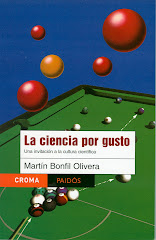Published in Milenio Diario, August 5, 2009
 Popularising science is placing scientific culture in reach of the general population: to turn science into a part of pop culture.
Popularising science is placing scientific culture in reach of the general population: to turn science into a part of pop culture.
One way to do it is through exhibitions and museums, in which many visitors have the opportunity of directly experimenting and getting close, in a special surrounding, to the objects, phenomena and concepts of science.
But this is seldom achieved in such a marvelous way as in the exhibition "Huellas de vida" (life's footprints), which Mexico City's government and the Museo del Desierto (the dessert museum) from Saltillo, Coahuila, together with other institutions, have installed in the city's main square since May 22.
I confess that I approached the exhibition with some skepticism: I am accustomed to visit science museums, and didn't think I'd find something to amaze me. I was wrong.
From the first enormous fossil fish, with its monstrous mouth filled with teeth, that welcomes you in the first chamber, the journey is full with marvels. Complete fossils, some original and some replicas of superb quality, of terrestrial and "aerial" dinosaurs (actually, pterosaurs; among them, the grand Quetzalcoatlus). Robotic models, specimens of "living fossils" and of species that help us compare the routes from which evolution, sometimes, produces similar results in very different species. Actual, live paleontologists showing how they work.
And a really professional museography, in which the specimens can be enjoyed with safety, and the professional and enthusiastic attention of many young guides, perfectly prepared to answer even the oddest questions from an avid public.
Of course, going to the exhibition will not turn you into a dinosaur expert. But that's is not the idea. A science exhibition must only, as Carl Sagan begged, "spark the sense of wonder". This the exhibition fully achieves. Other museums should take it as an example to follow.
Honestly, don't miss it. It opens from 9:30 to 19:30 from Monday to Sunday. But hurry up: it ends on August 31. And if this was not enough, it's free! What a magnificent gift for the citizens of our city.
(translated by Adrián Robles Benavides) To receive Science for pleasure weekly
in your email, subscribe here!




No comments:
Post a Comment